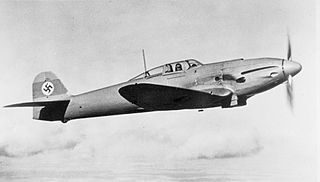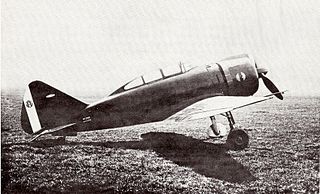Related Research Articles

The Heinkel He 112 is a German fighter aircraft designed by Walter and Siegfried Günter. It was one of four aircraft designed to compete for the 1933 fighter contract of the Luftwaffe, in which it came second behind the Messerschmitt Bf 109. Small numbers were used for a short time by the Luftwaffe and some were built for other countries, with around 100 being completed.

The Focke-Wulf Fw 187 Falke ("Falcon") was a German aircraft developed in the late 1930s. It was conceived by Kurt Tank as a twin-engine, high-performance fighter, but the Luftwaffe saw no role for the design, perceiving it as intermediate between the Messerschmitt Bf 109 and Bf 110. Later prototypes were adapted to two-seats to compete with the Bf 110 in the heavy fighter (Zerstörer) role, but only nine aircraft were built in total.
The MG 17 was a 7.92 mm machine gun produced by Rheinmetall-Borsig for use at fixed mountings in many World War II Luftwaffe aircraft, typically as forward-firing offensive armament. The MG 17 was based on the older MG 30 light machine gun, as was its defensive flexible-mount counterpart, the MG 15 machine gun.
In the years leading up to the outbreak of World War II in Europe in 1939, there was some significant collaborative development in heavy industry between German companies and their Japanese counterparts as part of the two nation's evolving relations. This was one major factor in Japan's ability to quickly exploit raw materials in the areas of the Empire of Japan that had recently come under their military control.

The Reggiane Re.2000 Falco I was an Italian all metal, low-wing monoplane developed and manufactured by aircraft company Reggiane. The type was used by the Regia Aeronautica and the Swedish Air Force during the first part of the Second World War.

The MÁVAG Héja ("Hawk") was a Hungarian fighter aircraft of World War II based on the Italian Reggiane Re.2000. The 70 Re.2000s delivered from Italy were converted into MÁVAG Héja Is by being fitted with Hungarian-built Weiss Manfréd WM K-14 engines, armor for the pilot, an additional fuel tank, and being modified in various other ways. The MÁVAG Héja II was an entirely Hungarian-made fighter developed from the Héja I, but with even more changes, including replacing the Italian machine guns with better Hungarian ones and installing a more powerful Hungarian engine.
The German Air Ministry had a system for aircraft designation which was an attempt by the aviation authorities of the Third Reich to standardize and produce an identifier for each aircraft design's airframe type produced in Germany. It was in use from 1933 to 1945 though many pre-1933 aircraft were included and the system had changes over those years. As well as aircraft of the Luftwaffe, it covered civilian airliners and sport planes, due to the RLM handing all aviation-related matters in the Third Reich, both civilian and military in nature.

The Varga RMI-1 was a twin-engine turboprop-powered aircraft designed by Hungarian engineer László Varga, and the world's first turboprop aircraft. It was a fighter-bomber intended to test the new turboprop Jendrassik Cs-1 aero engine. Only one prototype was built, as with the signing of a mutual defence pact between Hungary and Germany in June 1941, it was decided to license produce the Daimler-Benz DB 605 piston engine and purchase the Messerschmitt Me 210 fitted with these engines to fill the fighter-bomber requirement. Due to difficulties with the original engines, the sole prototype was re-engined with German Daimler-Benz DB 605s in 1944 and undertook taxiing trials and high speed runs, but was destroyed by Allied bombing in June 1944 before making its first flight.

The Weiss Manfréd WM-23 Ezüst Nyíl was a Hungarian fighter aircraft of World War II developed by the Manfréd Weiss Steel and Metal Works. Designed by Samu Béla and his team, the WM-23 was an entirely Hungarian design with retractable landing gear, a three-bladed variable-pitch propeller, a closed canopy, inverted gull wings and an elliptical low-wing design. Development started in summer 1939 with one prototype produced and test flown. Demonstrating good flying characteristics and generally being considered an excellent design, the WM-23 was planned to enter mass production. However, the prototype was destroyed on 21 April 1942, and by this time the MÁVAG Héja fighter was being used which acceptably filled the intended role of the WM-23. Therefore, it was decided to not allocate further resources to completing the project, and to cancel it.
References
- ↑ Bernád, Dénes; Punka, György (22 August 2013). Hungarian Fighter Colours – 1930-1945: Volume 1. Vol. 1. Mushroom Model Publications. ISBN 978-8361421719.
- ↑ Bernád, Dénes; Punka, György (13 February 2014). Hungarian Fighter Colours – 1930-1945: Volume 2. Vol. 2. Mushroom Model Publications. ISBN 978-8363678210.